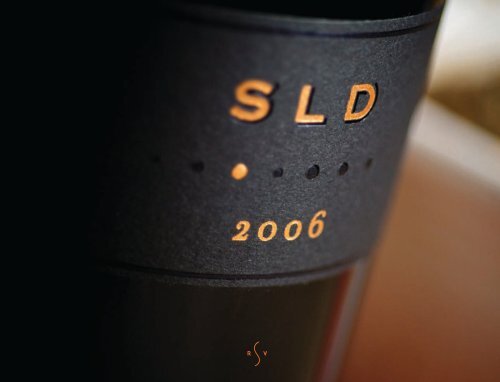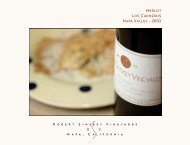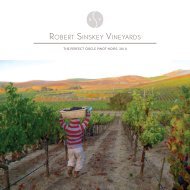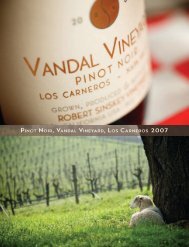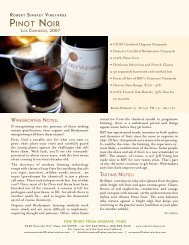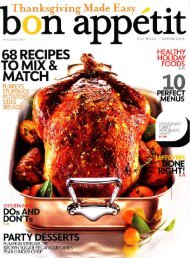Untitled - Robert Sinskey Vineyards
Untitled - Robert Sinskey Vineyards
Untitled - Robert Sinskey Vineyards
Create successful ePaper yourself
Turn your PDF publications into a flip-book with our unique Google optimized e-Paper software.
ANat u r a l, Or g a n i c or Biodynamic, Oh My!Ma k i n g se n s e of g r e e n win e m a k in g ... a n d m a r k e t in g .By Rob <strong>Sinskey</strong>s the cliché goes, it’s not easy being green. Nomatter how true the intent, someone will alwaysfind something you do, or don’t do, not greenenough. We might as well paint a big bull’s-eye onthe cellar doors.Just in the past few months, articles on “naturalwine” have appeared in the SF Chronicle (http://tinyurl.com/yhzyest), LA times (http://tinyurl.com/ye9sfrm) and the NY Times (http://tinyurl.com/yj5jz95). They were thought provoking, illustratinghow today’s wine drinker is looking for a newdefinition of “luxury wine.” The problem isthat the four major categories, “Sustainable,”“Organic,” “Natural,” and “Biodynamic,” areill-defined and riddled with pitfalls andcontradictions. It all boils down to intent.“Sustainable” is the most difficult term toget a handle on. In the purest sense, itcovers the three “E”s: Ecology, Economyand Social Equity. Thus, a farm shouldremain economically viable, pay its workersa living wage and maintain a viable andhealthy ecosystem in and around thefarm. Unfortunately, sustainable-in-practiceusually means the farmer thinks aboutnatural methods, but reserves the right touse herbicides and pesticides when it makesbetter financial sense.“Organic” is a term governed by the National OrganicProgram (NOP) under the United States Departmentof Agriculture (USDA) and use of the term in anylabel or promotional material requires certificationwith an NOP-approved certifier. There are a couple ofcategories when it comes to organic and wine: winesmade with organically grown grapes, where only thevineyard is organically certified, and organic wine,where the winery is also an organically certified( 1 ) Cabernet Sauvignon - “SLD” Stags Leap District - Napa Valley - 2006
processor. Organic certification in the vineyardmeans the farmer only uses naturally occurring nonsyntheticinputs. While this is a good baseline ofpurity, “organic” does not address sustainability. Forexample, there are only minimal requirements forsoil health and tilth. Also, keep in mind that naturalherbicides and pesticides, like the chrysanthemumderived pyrethrins, may be used instead of synthetics.The upside is that these natural born killers are shortlived, breaking down to natural elements rapidlywithout known carcinogenic or neurotoxic residue.Organic wine certification is problematic. A wine canbe “pure,” nothing synthetic added, yet still not meritorganic status due to one little element. Fermentedbeverages generally contain sulfur as a byproduct offermentation, and 99% of the world’s winemakers addsmall amounts as a preservative. The USDA feels theneed to warn the consumer about the levels of sulfiteswith these confusing labeling standards:1. Up to one part per million (ppm) - “No Sulfites”can be printed on the label. I have never had awine that had less than one part per million ofsulfites.2. Up to 10 ppm - “Contains only naturally occurringsulfites—no sulfites added,” or no mention ofsulfites at all. I would assume any wine that fallsinto this category would not print the warning.Again, it is rare to find wines in this category,and even rarer to find one in good shape.3. Any wine with more than 10 ppm must havea “Contains Sulfites” warning on the label.Conventional wines are allowed to contain upto 350 ppm, while a certified organic wine musthave fewer than 10 ppm, occurring naturally. Awine carrying “made with organic grapes” on thelabel must contain less than 100 ppm of combinednatural and added sulfites.The contradiction runs deep. Organically growngrapes have the same sulfite warning on the labelas a conventionally farmed wine, even though theallowable levels of sulfur are much less in bothorganic models (Organic wine and Organically grown)than conventionally farmed wine. Unless refrigeratedand consumed in the near term, wine is susceptible tooxidation and spoilage. Sulfur is the most innocuouspreservation method. Sulfur is, after all, the tenthmost abundant element on earth. It is a part of everycell in our bodies and naturally exists in many thingswe consume. It has been used as a natural preservativeCabernet Sauvignon - “SLD” Stags Leap District - Napa Valley - 2006( 2 )
in food and wine for millennia. Unless allergic, mostpeople are unaffected by sulfur, confusing reactionsfrom histamine, alcohol and yeast, with sulfites. I amsulfur sensitive yet, at levels well below 100 partsper million, I am unaffected by sulfur in my wine. Ialso have allergic reactions to certain yeast strainsin beer and champagne, penicillium (in certainblue cheeses) and other natural items that carry nowarning. Who is being protected when a conventionalwine is allowed up to 350ppm of sulfur yet carries thesame warning as an organically grown wine with lessthan 100ppm?The meaning for “natural wine” is unclear. The closestanyone has come to defining wines in this categoryfollow these guidelines:1. Organically or Biodynamically farmed2. Hand harvested3. Ferment with indigenous yeast4. Minimal or no sulfite additions5. Nothing artificial addedThere is no regulatory agency or standard for “naturalwine” or for the use of the term. I believe we makenatural wines, yet even though our vineyards arecertified organic and Biodynamic, an extremist wouldtake issue with some of the things we do in thecellar. First, we use stainless steel tanks and controltemperature. The wines start on ambient yeast, butif the fermentation sticks, or takes off in a funkydirection, a non-aromatic yeast is added to regaincontrol of the “wild” fermentation. However, if thewild fermentation takes the wine in a good direction,we let it go.( 3 ) Cabernet Sauvignon - “SLD” Stags Leap District - Napa Valley - 2006
Describing yeast as wild or indigenous is imprecise.A better term would be “feral” yeast. Yeast iseverywhere. It is in the air. It exists on grapes. Inour little valley, populated by hundreds of wineries,most wine yeast strains escaped from the cellarsas composted grape pressings and spread into thevineyards. Just over the hill is a commercial brewerythat exhausts its content into the air. So an argumentcan be made that what we think is wild yeast is justcommercial yeast gone rogue. Are you really expressingthe terroir of the place by only fermenting with aferal yeast? If a packaged yeast is not an aromatictype, that is, if it does not impart a foreign flavor oraroma on the wine, then it is a natural, non-syntheticproduct that assures the character of the vineyardcan show through by avoiding off-aromas and flavors.I think this a good, natural, insurance policy.Finally, “Biodynamic” (BD) is the most complex andritualistic of the methods. Biodynamic certification(and even the use of the word “Biodynamic”) isclosely regulated by Demeter USA. It is also brokeninto two parts: Biodynamic Farm and BiodynamicWinery. The BD approach is to look at the entirefarm as an interrelated, living entity. It is a holisticapproach that believes the farmer’s role is to healthe damage done by farming and leave the earthin a better, healthier state. A Biodynamic farm isinherently organic, but Biodynamic certificationgoes much further by addressing the health of thesoil, encouraging vigorous populations of microbesand embracing the natural structure of the earth.Being a Biodynamic farmer means that you are on a”“Organic” does not address sustainability.mission to find the natural rhythm of the farm andprevent problems before they occur. The pitfall”inBiodynamics is that even though there are some basicguidelines, it is more of a self guided journey.Many people ask why we don’t state that we farmBiodynamically on the label. Simply put, we are nota Demeter certified Biodynamic winery. Even thoughRSV makes wine only from our certified Biodynamicvineyards, Demeter requires a winery to also becertified before any statement can be used on a label.However, being a Biodynamic winery is currentlycontroversial. The US regulations are different fromthe EU regs. The idea is to make wines as “natural”as possible, but, as I discussed earlier, no one reallyknows what that means. For instance, some feel thatmicro-oxygenation of the wines is natural; we begto differ. Because of this uncertainty, we remainundecided as to whether we will proceed withBiodynamic winery certification.Confusing? Yes! That is why you need to know yourfarmer and your vintner. Here at RSV, we do our bestwith the tools on hand and continue to learn as wego, but we are not without some contradictions. Allwe can do is constantly try to improve our naturaltechniques while improving the quality of our wines.Cheers,RobCabernet Sauvignon - “SLD” Stags Leap District - Napa Valley - 2006( 4 )
”Winegrowing No t e sBy Eric SothernJ ust shy of five acres, RSV’s SLD Estate vineyardwraps around the winery in a horseshoe shape,rising up into the Vaca range in steep terraced steps.Minimal irrigation and rocky volcanic soils severelylimit yields and prompt the vine to produce a smallcrop of very intense, yet balanced, fruit.Relatively cool weather prevailed in spring andalmost the entire summer, but for a hot spell at theend of July and into the first week of August. Thecool weather made for gentle development of sugars,extending the growing season, allowing for moretime to develop flavors, all while preserving preciousacidity. Harvest took place on September28th, 2006. After completing fermentation instainless steel, the wine rested in 45% newFrench oak barrels for 20 months. 4 acres ofCabernet Sauvignon and 1/2 acre of Merlotcontributed to the blend. 35 barrels produced.“Sustainable” is the most difficultterm to get a handle on. In the purestsense, it covers the three “E”s: Ecology,Economy and Social Equity.”Ta s t i n g No t e sThe wine first seduces the eye, flauntingtranslucent brilliant ruby color, with morered-tones than usual for the SLD Estate Cab.Classic Cabernet Sauvignon aromas of black currant,blackberry, plum, olive and dried herb (anise, fennel,mint) prompt a sip that fills out the aromas and wrapsthe palate in silk. Fresh, vibrant acidity balances therich flavors and, along with the wine’s supple, ripetannins, begs culinary suitors. While many CaliforniaCabernet Sauvignon jump out of the glass, grab youby the throat, and scream at you, this wine speakssoftly, has a lot to say, and keeps you coming back tolisten. And it’ll be talking for a long, long time. EricSothern - 10/23/2009100% CCOF Certified Organic and Demeter Certified Biodynamic <strong>Vineyards</strong>( 5 ) Cabernet Sauvignon - “SLD” Stags Leap District - Napa Valley - 2006
Cabernet Sauvignon - “SLD” Stags Leap District - Napa Valley - 2006( 6 )
Ou t wi t h th e ne w, in wi t h th e ol d …Ihaven’t made a terrine in a long, long time. At one point inmy life, it was my job at a small luxurious hotel to ensurewe always had some style of terrine on hand. We’d slice theterrines into small, chunky triangles for charcuterie trays, loadedwith sliced meats, cornichons, pickled onions and spicy mustard. Ienjoyed gathering the leftover scraps from butchery and makingthem into something thrifty and delicious. I’d stud them withpistachios, brandy soaked-fruit or pieces of foie gras, whatever Ifancied at the time of creation.Today, each time I visit the Fatted Calf, I gaze upon their neatlyspaced row of various terrines, sparking my memory of my terrinemakingdays. I decided to get back in the mode by whipping upterrines for frequent entertaining. Both of these are wonderfullyscented with herbs and aromatic vegetables to pair with the cassis,blackberry, and olive fruit of RSV’s SLD Cabernet Sauvignon.Don’t save the wine for the main course, rather serve it with asumptuous buffet of cow’s and sheep’s milk cheeses, a variety ofterrines, sliced meats, grilled vegetables and your favorite horsd’oeuvres. This year, have everyone over for a casual holiday noshinstead of an elaborate multi-course meal.I love the covered terrine mold from Revol, the century-old,family owned, French company based in Lyon, France. When it’snot in use for terrine making, I use it to serve hearty salads orconceal homemade cookies or caramels until their revelation afterdinner.Enjoy time spent with your family and friends.Until the next wine…Maria( 7 ) Cabernet Sauvignon - “SLD” Stags Leap District - Napa Valley - 2006
Po r k a n d Du c k Te r r i n e wi t h Gr e e n Ol i v e sMy inspiration for this recipe came from my friends at the Fatted Calf, who stud their deliciously aromatic anddelicately spiced terrines with bright green, jewel-like Castelveltrano olives. Yields one large terrine.2 1/2 pounds ground pork, medium grind1 1/2 pounds ground boneless duck legs, mediumgrind1/4 cup minced shallots4 medium garlic cloves, pressed1/2 teaspoon Quatre Epices1 cup pitted Castelveltrano Olives or similarmeaty green olive1 teaspoon chopped fresh thyme2 teaspoons chopped fresh rosemary4 teaspoons kosher saltFreshly ground black pepper1.In a large bowl, mix all of the ingredients together well. Form a thinpatty and cook in a sauté pan until well done to check for seasoning.Add more salt or pepper if necessary.2. Press the mixture into a terrine mold and cover. Overflow can bebaked in another baking dish covered with foil.3. Place the terrine in a roasting pan and fill with hot water to reachhalfway up the side. Place the pan in the oven and bake for 1 hour15 minutes until a thermometer registers 150 degrees F. Remove theterrine form the oven carefully and let it sit in the hot water bathuntil slightly cool. Remove the lid and pour off half of the juices andfat from the terrine and discard. Place a foil-covered piece of thickcardboard cut to fit inside the rim of the terrine mold and press down.Weight with cans and place in the refrigerator in a pan to catch thefat and juices. Chill overnight. Run a knife around the edge of theterrine to loosen. Turn out the terrine and slice to serve. Freezewell; cryo-vac or wrap well in plastic.Cabernet Sauvignon - “SLD” Stags Leap District - Napa Valley - 2006( 8 )
He r b e d Po t at o a n d Mu s h r o o m Te r r in eThis vegetable terrine, packed with aromatic vegetables and herbs, is savory and satisfying. It is a delicious vegetarian optionfor pre-meal nibbling or as a first course. Yields one large terrine.6 large Savoy cabbage leaves2 packed cups fresh breadcrumbs1 cup heavy cream2 1/2 pounds Crimini mushrooms3 tablespoons extra virgin olive oil divided1 cup dry red wineKosher saltFreshly ground black pepper2 tablespoons finely minced shallots6 garlic cloves, pressed2 tablespoon chopped fresh thyme1 pound creamer size Yukon Gold or German Butterballpotatoes, cooked and peeled2 egg whites2 tablespoons chopped fresh flat leaf parsley1. Blanch the cabbage leaves in boiling salted water for 1minute. Drain and pat dry. Slice the ribs of the cabbageleaves even with the leaf so that the leaves are flat.2. Trim off any dirty mushroom stems. Rinse briefly if themushrooms are dirty and drain. Pop the stems off of 16mushroom caps.3. Heat a medium sauté pan over medium high heat. Add1 tablespoon olive oil and the 16 mushroom caps. Sautéuntil the mushrooms are golden and dry, season with saltand pepper. Add 1 cup red wine and reduce until themushrooms have absorbed the wine and the pan is almostdry. Turn out the mushrooms onto a plate and reserve.4. Heat a large sauté pan over medium high heat. Add 2tablespoons of olive oil and the remaining mushroomsand stems. Cook until the mushrooms start to exude theirjuices. Add the shallots, garlic and thyme and cook untilthe pan is dry and the mushrooms are golden, season withsalt and pepper to taste. Cool.5. Place the mushrooms in a food processor and chop finely,season with salt and pepper to taste. Puree in the egg whitesand parsley until smooth. Add the breadcrumb mixture andblend until smooth.6. Place 1 1/2 inches of the mushroom duxelle in the bottom ofthe terrine mold. Cut the potatoes in half and place a layeron top of the mushrooms pressing the rounded side into theduxelle. Top with another layer of duxelle and then themushroom caps with rounded side pressed into the duxelle.Top with duxelle and then another layer of potatoes. Finishwith a thin layer of duxelle. Fold over and press the endsof the cabbage leaves into the layer of duxelle to cover thetop. Place the lid on the terrine and place in a roasting panwith hot water, the same as for the pork and duck terrine.Bake until the thermometer registers 145 degrees, about 1hour and 15 minutes. Remove from the water bath and pressin the same manner as the Pork terrine.( 9 ) Cabernet Sauvignon - “SLD” Stags Leap District - Napa Valley - 2006
Cabernet Sauvignon - “SLD” Stags Leap District - Napa Valley - 2006( 10 )
Ca b e r n e t Sa u v i gn o n“SLD” St a g s Le a p DistrictNa p a Va l l e y, 2006Winemaker: Jeff VirnigRecipes: Maria Helm <strong>Sinskey</strong>Photos and Text: Rob <strong>Sinskey</strong>Tasting Notes: Eric SothernVineyard Manager: Debby ZygielbaumEditing: RSV Group EffortPrinted on 100% recycled paper using soy based inkR o b e r t S i n s k e y V i n e y a r d sN a p a , C a l i f o r n i aFine Wines from Organic Vines6320 Silverado Trail Napa, CA 94558 - tel 707.944.9090 or 800.869.2030www.<strong>Robert</strong><strong>Sinskey</strong>.com


